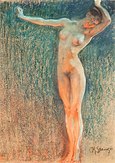Kazimierz Stabrowski
Kazimierz Stabrowski | |
|---|---|
 | |
| Born | Kazimierz Stabrowski 10 November 1869 |
| Died | 10 June 1929 Garwolin, Poland |
| Nationality | |
| Education | Imperial Academy of Arts in St. Petersburg |
| Known for | Painting |
| Movement | Symbolism |
| Spouse | Julia Janiszewska (1902) |
Kazimierz Stabrowski (November 21, 1869, Kruplyany – June 10, 1929, Garwolin) was a Polish painter, and director of the Academy of Fine Arts in Warsaw.[1]
Biography
Kazimierz Stabrowski came from a Polish landed gentry (ziemiaństwo) family. In the years 1880 to 1887, he completed his education in Białystok, after which he studied at the Imperial Academy of Arts in St. Petersburg, where he was taught by Pavel Chistyakov, later (from 1895) in Ilya Repin's workshop. At the academy he gained contacts with numerous Polish painters, inter alia with Ferdynand Ruszczyc, Kazimierz Wasilkowski, Henryk Weyssenhoff, and Stanisław Bohusz-Siestrzeńcewicz, as well as with Russians.[2]
In 1893, he went on artist travels to the East, Beirut, and Palestine, in which he visited Odessa, Istanbul, Greece, and Egypt. Throughout his journey, he gathered a portfolio of work, he did his diploma painting Muhammad in the desert (The escape from Mecca) (Mahomet na pustyni (Ucieczka z Mekki)) during his travels.[3] In the years of 1897 to 1898, he did his further studies at the Académie Julian in France; it is there where he met numerous academics inter alia Jean-Joseph Benjamin-Constant, and Jean-Paul Laurens, and has been introduced into the artistic movements of Impressionism and Fauvism. After coming back to St. Petersburg, he participated in the regional sphere of artists, where he made numerous artworks, which he exhibited inter alia Paris, (at the World's fair in 1900), Munich (1901), and Venice (1903).[4]
In 1902, he married Julia Janiszewska, a sculptor, who he met at the Imperial Academy of Arts in St. Petersburg.[5] From 1902, he became a member of the Society of Polish Artists "Sztuka" (Towarzystwo Artystów Polskich "Sztuka"). In 1903, he moved to live in Warsaw, where he engaged in organisation and pedagogue. Together with Konrad Krzyżanowski he operated a private art school, which led to the reopening of the then closed after the January Uprising, School of Fine Arts in Warsaw.[6] The school opened in March 19, 1904. Kazimierz Stabrowski became the first director of the school, performing this function to 1909. Due to a conflict with the Pedagogue Council, and the Tutelary Committee, after being involved in Western esotericism, he dismissed himself.[7]
The years of 1909 to 1913, marked his second artist travels, inter alia France, Germany, Sweden, Spain, Italy, and the Canary Islands. The summer months he spent with his family in Lūznava Manor (Dłużniewo), Latvia.[8]
After World War I, he moved to St. Petersburg, when in 1918, he moved back to Warsaw.[9] After new aesthetics in Russia after World War I, his work gained criticism by pedagogues, and positive views by the journal Mir iskusstva. In the 1920s, he travelled again to find new artistic themes, to Greece, Turkey, Morocco, Bosnia, Sweden, and Norway. In 1922, he co-founded the artist group Sursum Corda. He died in 1929, he was buried at the Powązki Cemetery (Quarter 205-I-8) in Warsaw.[10]
Selected paintings
-
By the Stained Glass Window
(1908) -
Nude - Dawn
(1902) -
Nude with Peacock Feathers
(1900) -
Spanish Woman
(1928) -
Portrait of the Actress,
Wanda Siemaszkowska
(1910)
References
- ^ "Kazimierz Stabrowski Paintings". Culture. Retrieved 22 October 2015.
- ^ "Biography". Artyzm. Retrieved 22 October 2015.
- ^ "Wirtualne Muzeum Secesji". Muzeum Secesji. Retrieved 22 October 2015.
- ^ Folga-Januszewska, Dorota (2012). Jak czytać malarstwo polskie od XI wieku do 1914 roku. Kraków: Universitas. ISBN 97883-242-0833-3.
- ^ "Biography". Szkolnictwo. Retrieved 22 October 2015.
- ^ "Kazimierz Stabrowski (1869 - 1929, Polska)". Agra Art. Retrieved 22 October 2015.
- ^ "Author: Kazimierz Stabrowski". Wolne Lektury. Retrieved 22 October 2015.
- ^ "Kazimierz Stabrowski (1869 - 1929) Paintings By Artist". Desa. Retrieved 22 October 2015.
- ^ "Wtorkowe spotkanie w Muzeum Narodowym: "Wykładowcy z warszawskiej ASP: Kazimierz Stabrowski i Konrad Krzyżanowski"". Kulturalna. Retrieved 22 October 2015.
- ^ "Kazimierz Stabrowski (1869-1929)". Invaluable. Retrieved 22 October 2015.
External links
![]() Media related to Kazimierz Stabrowski at Wikimedia Commons
Media related to Kazimierz Stabrowski at Wikimedia Commons





